
Wednesday, 26 June 2013
Distance 24 km
Duration 7 hours 0 minutes
Ascent 547 m, descent 922 m
Maps 156 and 163 of the TOP100 lime-green series
Topoguide (Ref 7000) Le chemin de Régordane
We slept soundly in our spartan single beds, and arrived downstairs punctually for breakfast, which started at 7:30.
Even so we were not as punctual as the old couple who had shown such a turn of speed coming into the village the day before.
They were doing the Robert Louis Stevenson walk and were gone before we had half finished eating.

It was a rare treat to have such a spread for breakfast and we made the most of it. There was muesli on offer, but we preferred the novelty of toast, laden with butter and home-made jam.
Several slices of this, with a couple of bowls of milky coffee (heated to scalding point in the microwave), made a deeply satisfying start to the day.
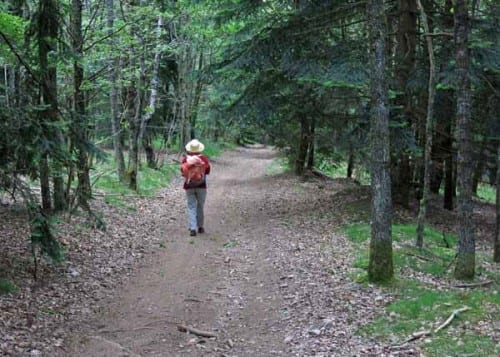
The fire was burning merrily in the grate as we sat at the long table, where a few other walkers were now quietly breakfasting.
We left at 8 o’clock, with many thanks to our affable host, then, parting company for the last time with the Stevenson walk, we crossed the bridge and set off up the hill. Past the church and the post office, the GR signs pointed up a small road which rose steeply through a forest and brought us to the highway, which we crossed.
The way was downhill after that, on a wide path among pines, which led to what used to be the main road before the D906 was put in. It had no trace of bitumen but was smooth and easy to walk on, following the contours of the slope.

The woods fell away on our left and rose to our right, with the occasional field. After a kilometre or so we turned off up a steep, stony track and came out into open pasture at the top of the range.
To the east, the blue massif of the Borne, creased by deep valleys, stretched away impressively to the horizon.
We rejoined the highway at the tiny village of le Thort, possibly the most exposed spot in France.
All around the solid little houses, the fields dropped away, and we felt a chill wind, even on a calm, sunny day such as this.
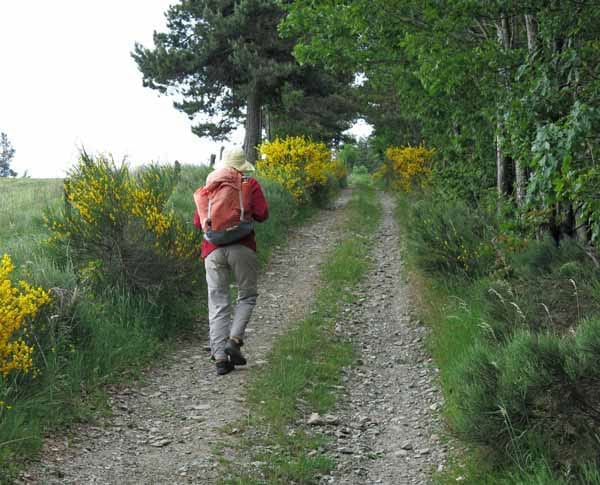
We were out of the village almost as soon as we entered it, and set off along a small road.
Soon we came to a large, intact dolmen – a prehistoric burial chamber covered by a stone slab of breathtaking size. Apparently dolmens were often placed beside main routes like this.
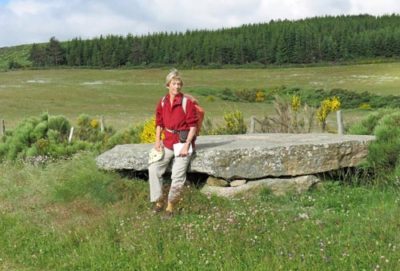

A bit further on we left the road at a corner, and continued straight ahead between a pine wood and a sloping meadow.
There was no doubt that we were now on the actual footprint of the Régordane. In places the ground was solid rock, and there were deep grooves worn by the wheels of the carts.
It was impossible to imagine how many carts must have passed this way to create such grooves, but we later found out that it was not all wear and tear.
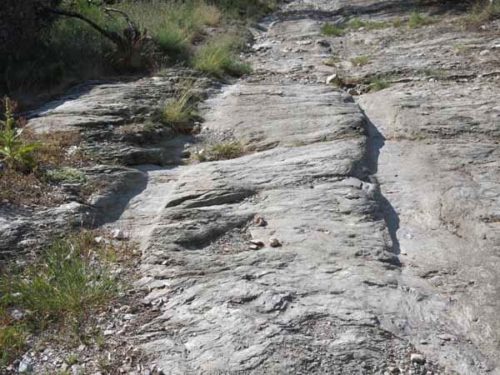
In mediaeval times, grooves were intentionally cut into the rock, like tram-lines, to keep the carts steady on side-sloping sections.
It was a beautiful walk along the top of the ridge, with expansive views on either side. Some parts of the track were a rough, dusty wheel-track, others still showed signs of the elaborate stonework of the Régordane in its heyday.

We crossed the highway again at la Molette, and a few kilometres further on we came to a hand-drawn sign pointing to a café. It was definitely time for refreshments, we thought, even if it meant descending to the valley.
The path to the village of Prévenchères zig-zagged down a well-worn stony track on a gorse-covered slope.
Having seen no other walkers all day, we were surprised to see one approaching us up the hill. It turned out to be a wild-haired man clad all in black, who glared at us with hatred as he passed by.

He was not carrying a pack and was no doubt a local, of the same breed as the hostile, muttering old fellow that we had passed yesterday on the track near les Fagoux. Neither of them seemed keen on being invaded by outsiders like us.
At the bottom of the descent we went under the railway line and into the quiet streets of the village.
We crossed a stream lined with vegetable gardens and came to a large, beautiful church, made of light-coloured stone, with its gracefully rounded east end and its bell-tower in the shape of a comb.

The rest of the village was unremarkable, although attractive enough. The main road went along the edge of the small river Chassezac, which flowed, not into the Allier, but the other way, into the Ardèche We had crossed the watershed since leaving Labastide-Puylaurent.
We found the café, Lou Palhio, tucked into the corner of a crooked street. The terrace, with its umbrellas and pots of flowers, looked lovely, but we went indoors because of the cold, and enjoyed our coffee in the empty dining room while the barwoman bustled about with a broom – she had only just opened for the day, at 11 am.
The place looked new, but she said that it was five years old. They also had rooms to let overnight.

On the way back to the Régordane, we followed a GRP up the other side of the declivity, and arrived at the top of the ridge a little further along from where we had left it.
The GR then plunged off to the left, down a loose, rocky goat-track. We could see the path rising across the bare hillside ahead of us, but the valley was deeper than it looked.
On one of the steepest sections Keith stumbled and fell, ending up with his legs in the air, and his face pressed into a gorse bush by the weight of his pack.

At last we made it to the valley floor, where there was footbridge. The climb that followed was shorter and not as rough, and before long we were amongst trees again.
After crossing another stream at a mysterious group of ruins, the track joined a wide forestry road, which was much easier going.
As the road curved around a small valley we saw a slightly ramshackle, brightly-painted house with vegetable plots stretching down to the stream, and a rough lawn where goats bleated and chickens fossicked among fanciful home-made sculptures.
There was also an orchard and the whole was enclosed by a tall new barbed-wire fence, presumably to keep the outside world away from this little self-sufficient paradise. They did not even seem to have electricity.
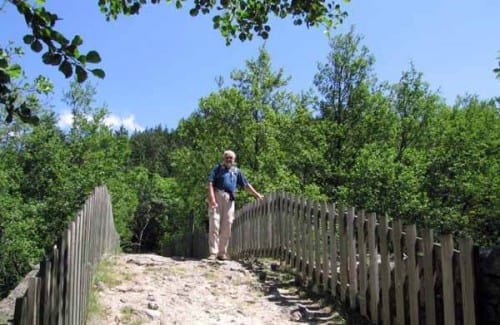
Just past this we came to a fork in the track and turned right over the river. This was the Chassezac, last seen at Prévenchères.
There was a lone walker sitting on the bank eating lunch – we recognised him from last night at the gîte. We waved and kept going, under the railway line, where came to four more walkers similarly engaged and then a seated couple pouring coffee from a vacuum flask. They must have all passed us while we were deviating to Prévenchères.

We pressed on along the old road, ignoring the detour to the perched village of Albespeyre, then took a rising path through trees to the open plateau.
Soon the legendary village of la Garde-Guérin, with its tower and encircling wall, could be seen far away, but first we had to go past an incongruous golf club, whose happy, raucous clubhouse diners rather ruined the mediaeval dream that we were enjoying.

La Garde-Guérin, with its sweeping views of the surrounding countryside, was set up in the twelfth century specifically for travellers on the Régordane, who paid fees in return for protection and shelter.
It was ravaged and burnt in the Hundred Years War and again in the Wars of Religion. Only recently has it been restored and it is now yet another lifeless Plus Beau Village.


By this time (1:30 pm) we were getting tired, so when we got to la Garde-Guérin, after a brief look around, we sat on a wall and had a bite of bread and cheese.
We still had five kilometres to go to our destination of Villefort, so we hurried on, crossed the highway and followed a grassy track along the edge of the escarpment for a while, until it suddenly turned and began to twist down in zig-zags towards the lake of Villefort. The path was wide and well made, with sturdy stone edging, no doubt the original Régordane.
At the foot of the descent we entered tourist country. Camping grounds, restaurants and hotels lined the highway and we were lucky to find a small path to walk on, otherwise we would have been on the bitumen with the cars.

The lake is not natural – it was formed by the construction of a huge dam, over which we walked. Reportedly there is an old road and bridge drowned under the waters of the lake.
Behind the lake we could see the massive hump of Mont Lozère, where the Stevenson track went. It was easy to see why the Régordane, a working trade route rather than a holiday ramble, skirted this obstacle via the geological fault line running through Villefort.
From the dam we walked beside the highway, past a roundabout and up to the town. In the streets, we crossed a little hump-backed bridge with a plaque commemorating the opening of the GR700 in 2008.

The main square was pleasantly shaded with trees and had several bars. For the first time this trip, we sat outside, admittedly with our warm jackets on, to have coffee. There was a lively feeling about the place which promised well for the evening, but all the same we visited the nearby Office of Tourism to ask about restaurants.
Unfortunately we forgot to find out where the camping ground was, and set off rather aimlessly up the highway, under the railway line, to the last houses of town, where the road curved up towards a wooded col.

We saw a man in a car workshop and went in to ask him, getting the unexpected reply – “It’s just there!”, pointing up the road a hundred metres. Keith was so pleased that he shook the man’s hand, as if he had personally arranged to put it there for our benefit.
At the camping ground, the office was closed but there were plenty of campers about, including some cyclists with tiny tents like ours. It was the steepest camping ground that we had ever seen, with each grassy level separated by quite a cliff.

We chose the lowest level, but had to toil up dozens of concrete steps to get to the shower block, one level above. Luckily it was worth the effort – sparklingly new and well-equipped.
After a sleep in our clean clothes, we strolled back to the village, noticing where the GR turned off, just near the railway underpass. This meant that we would only have to come half way down in the morning.
Our first choice for dinner was the restaurant la Clède, in the Hotel Balme, which was offering a menu for €17.50. Inside, everything was hushed and gracious. Once we were seated, the waitress explained that for €17.50 you got either an entrée or a main dish, followed by dessert. It did not sound enough for our walkers’ appetites, and the actual dishes seemed light and uninteresting, so we got up as discreetly as possible and slunk out.

There were only a few brasseries to choose from after that. The first one did not serve meals in the evening, the second (recommended by one of the drinkers in the first) was closed, and we ended up in a very unpretentious place eating a standard meal of large salad, followed by steak and pasta.
There were other people eating as well, so the atmosphere was surprisingly pleasant.
Arriving back at the camping ground, it occurred to us that we could probably meet the GR at the col above, instead of going back to the railway underpass, thus saving even more effort in the morning.
As we were consulting the map, the manager of the camping ground came past and relieved us of €8.40 for the night – the normal absurdly cheap price in municipal campsites.
Previous section: Le Puy-en-Velay to la Bastide-Puylaurent